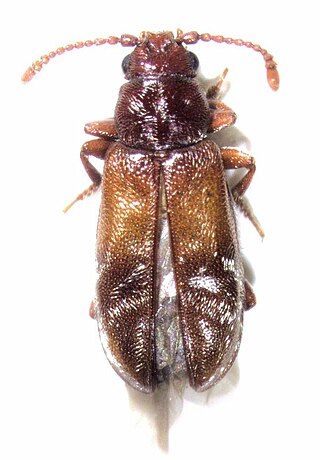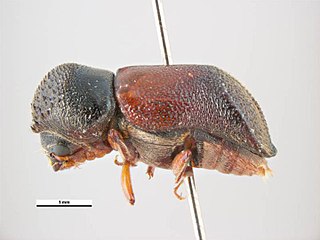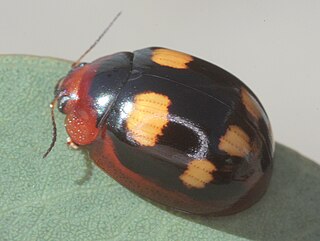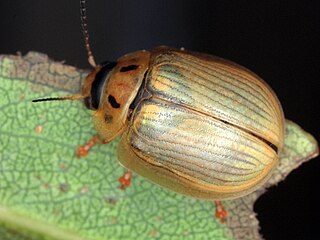
The sap beetles, also known as Nitidulidae, are a family of beetles.

The Asian long-horned beetle, also known as the starry sky, sky beetle, or ALB, is native to the Korean Peninsula, northern and southern China, and disputably in northern Japan. This species has now been accidentally introduced into the eastern United States, where it was first discovered in 1996, as well as Canada, and several countries in Europe, including Austria, France, Germany, Italy and UK.

The longhorn beetles (Cerambycidae), also known as long-horned or longicorns, are a large family of beetles, with over 35,000 species described.

Cavognathidae is a family of beetles, in the superfamily Cucujoidea. It contains a single genus, Taphropiestes with around a dozen species known from South America, Australia and New Zealand. In Australian and New Zealand species adults and larvae have been found living in bird nests, but their ecology is unclear, but they are possibly scavengers.

Xylopsocus gibbicollis, common name "common auger beetle", is a species of beetle of the family Bostrichidae.

Gonipterus gibberus is a species of weevil in the family Curculionidae. It is commonly known as the eucalyptus snout beetle, the eucalyptus weevil or the gum tree weevil. It feeds and breeds on Eucalyptus trees and is endemic to Australia.
Gonipterus scutellatus is a species of weevil in the family Curculionidae. It is commonly known as the eucalyptus snout beetle, the eucalyptus weevil or the gum tree weevil. It feeds and breeds on Eucalyptus trees and is endemic to Australia.

Eburia tetrastalacta is a species of beetle in the family Cerambycidae.
Anaphes nitens is a species of fairyfly, a chalcid wasp in the family Mymaridae. Native to Australia, it is an egg parasitoid of the gum tree snout beetle, a pest of Eucalyptus trees, and has been used in biological pest control of that species.

Paropsisterna is a genus of leaf beetles indigenous to Papua New Guinea and Australia. There are over 120 species, many with bright aposematic colours, and many feeding on Eucalyptus leaves.

Paropsisterna bimaculata is a beetle commonly called a leaf beetle in the subfamily Chrysomelinae. This insect is common in Tasmania and can be a pest in the forestry industry. Paropsisterna bimaculata will develop a red colour just before their winter hibernation. When they emerge the red slowly disappears into a pale green colouring with faint gold tessellation. This takes about a month with the males generally slightly advanced. Recently this beetle has been noticed in Victoria.

Anoplognathus brunnipennis, commonly known as the brown- or golden-brown Christmas beetle, is a beetle of the family Scarabaeidae native to eastern Australia, being common in coastal Queensland, New South Wales and Victoria, the Great Dividing Range and the Murray-Darling river basin.
Anoplognathus aureus, commonly known as the gold Christmas beetle, is a beetle of the family Scarabaeidae native to northern Australia, from northeastern Queensland to northern Western Australia. It is prized by collectors.

Aonidiella orientalis is a species of insect in the family Diaspididae, the armored scale insects. It is known commonly as the Oriental yellow scale. It is an agricultural pest on a wide variety of crop plants.

Paropsis charybdis, commonly known as the Eucalyptus tortoise beetle, is a species of leaf beetle belonging to the genus Paropsis. It is considered a pest of some species of Eucalyptus.

Oemona hirta, the lemon tree borer, also known as the whistling beetle or the singing beetle, is a longhorn beetle endemic to New Zealand. Its larvae are generalist feeders, boring into the wood of a wide variety of trees, native and introduced. When citrus orchards were first established in New Zealand, this beetle started inflicting serious damage, and so gained the name "lemon tree borer". Four species within the genus Oemona have been identified, suggesting that more species could be found. When disturbed by predators or humans, the adult beetle stridulates creating a "rasp" or "squeak" sound by rubbing its thorax and head together against an area of thin ridges. Māori would eat a liquid called "pia manuka", which was produced by manuka trees when its wood was damaged by the larvae. When Captain Cook first arrived in NZ, his naturalists, Banks and Solander, collected a lemon tree borer in their first collection between 1769 and 1771. This oldest collected specimen can be found in the British Museum. A few years after the first collection, the species would be first described by the Danish naturalist Fabricius in 1775.
Onitis crenatus, is a species of dung beetle found in Afro-Asian countries.

Planococcus ficus, commonly known as the vine mealybug, is a species of mealybug, belonging to the family Pseudococcidae, native to tropical and subtropical regions. The vine mealybug is found in Europe, Northern Africa, Southern Africa, the Americas, and the Middle East. The vine mealybug is invasive to weedy plants in many different regions of the world.

Gonipterus platensis is a species of weevil in the family Curculionidae. It is commonly known as the eucalyptus snout beetle, the eucalyptus weevil or the gum tree weevil. It feeds and breeds on Eucalyptus trees and is endemic to Australia, though it is also found in New Zealand, North America, Hawaii, and western Europe.
Gonipterus pulverulentus is a species of weevil in the family Curculionidae. It is commonly known as the eucalyptus snout beetle, the eucalyptus weevil or the gum tree weevil. It feeds and breeds on Eucalyptus trees and is endemic to Australia, though it is also found in South America.















